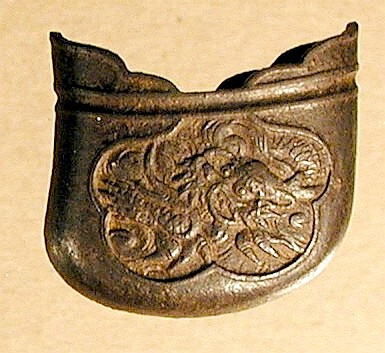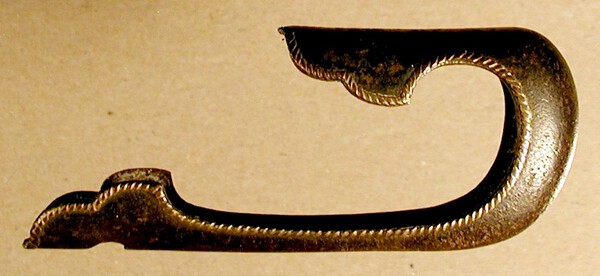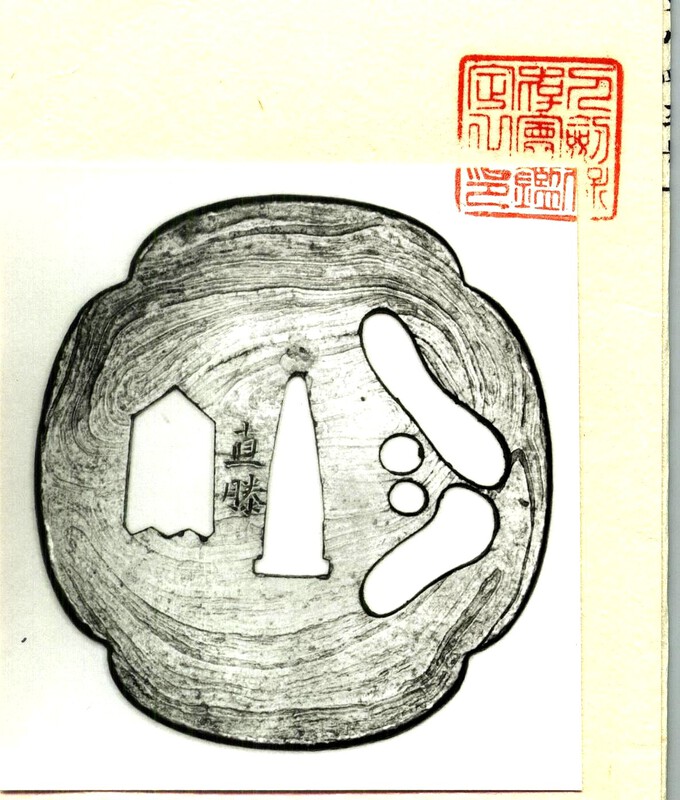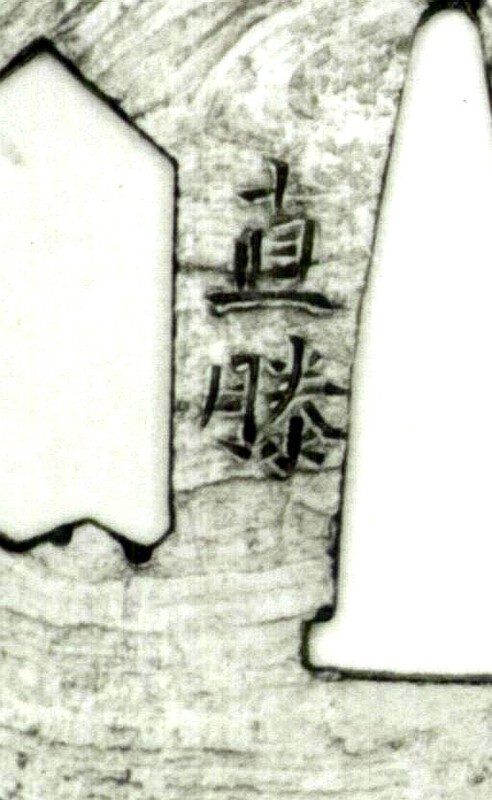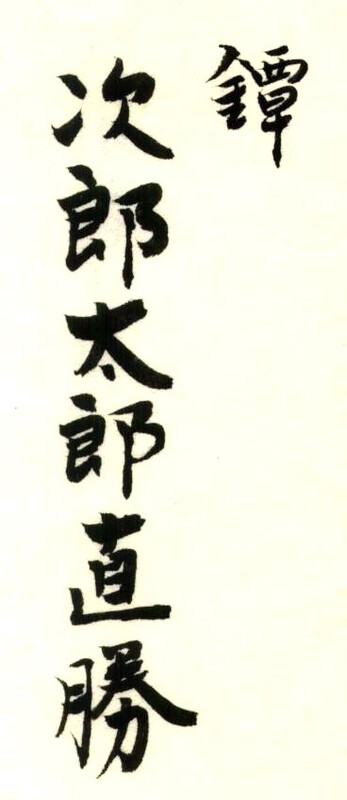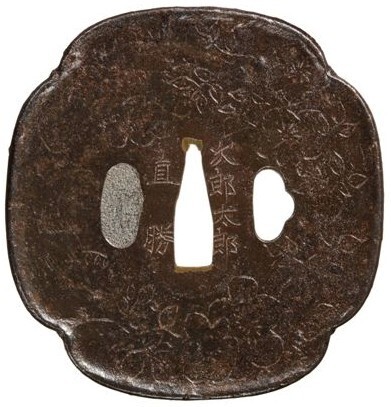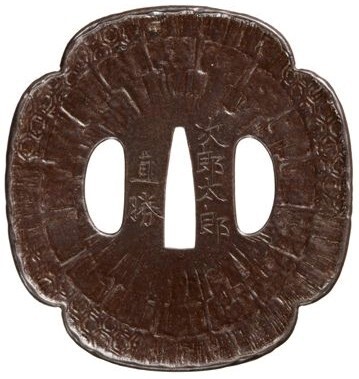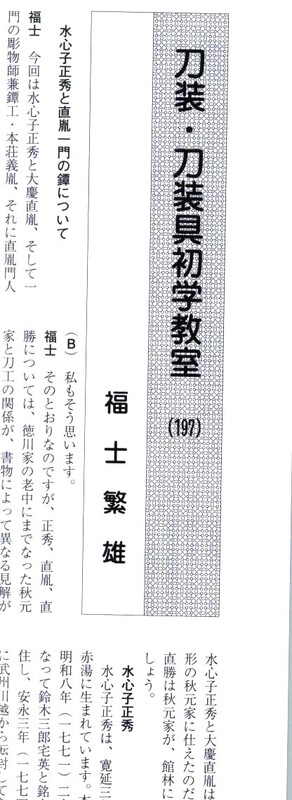-
Posts
703 -
Joined
-
Last visited
-
Days Won
4
Everything posted by Ron STL
-
While I can't say specifically where I heard this before, likely several places, one kantei point for recognizing shinshin-to (often copying swords of Nambokucho times) is the lack of niku. This characteristic can be very subtle and certainly not "in your face" kind of recognition thing, but it something to look for. I do believe this characteristic is mentioned in the kantei points section of various books and very likely in Yamanaka's writings, his Nihonto Newsletter from the 1960's. I wouldn't think this could be seen from photographs. You must handle and study swords from the various periods to really gain recongnition of this subtle "lack of niku." Ron STL
-
A Christmas Day last minute comment or two...I have a longer than normally seen Kanemoto (70.2 cm) which is what I like to call a "textbook" sword. There is an excellent description on "what to expect to see" in a Magoroku Kanemoto blade, in the Connoisseur book. When showing my sword to collectors who truly recognize Kanemoto's work, the first thing they notice and comment on in the hada. Their first comment is, "Ah, Kanemoto's hada!" Again, read up on this in the Connoisseur book and then look for it on a sword when opportunity knocks. Ron STL
-
John Yumoto used to say buying kogatana was like buying a pocket knife; you went to the shop and picked "the name" you wanted on the blade and that was it. Today, we are aware that swordsmiths did indeed make their own kogatana. I'm sure John was aware of this years ago but was speaking in general about kogatana, not the truly forged kogatana. I have saved a number of these by noted smiths and when polished, a beautiful hamon with ko-nie hataraka and fine jihada can be enjoyed! A fancier of Jirotaro Naokatsu, in Japan a few years ago I was offered an fine example for something like $1,200 or so, but declined because of the price compared to my interest level. There is an illustrated book written on kogatna showing authentic mei, but the name escapes me at the moment. I do use it and it is useful to determine "authentic" mei by known smiths. I'll dig out the title to the book unless someone else knows it. Ron STL
-
Here are the "puppy" menuki I mentioned. they are "thumbnail" size and of a couple grades of gold and shakudo. Guess this is okay with this topic...really not worth starting a new one. Ron STL
-
I have both the Goto book and Michibori book in my library and they are fantastic printings, but I do not find myself going to them on a regular basis to check out mei. Great to see what the works of these masters "should" look like, though. I still have the extra copy of the massive Goto book for sale ($430pp US) should anyone be looking for a Christmas gift. Trying to judge mei on tosogu, for me, is much more difficult than on swords. A few years ago I bought a wonderful, very small pair of gold menuki of "two puppies," signed Omori Teruhide with kao. Obviously, the mei and kao has to be oh so small to fit on these menuki, but they looked absolutely 100% to me, comparing to book examples. They ended up not passing NBTHK shinsa, to my disappointment...a pricey misjudgement on my part. I am still amazed at how accurately the mei is on these menuki. Ron STL
-
From what I can see, the boshi appears to be a continuation of the hamon and if so, I'd call this at least sue-koto, maybe Keicho period. Into shinto I would expect to see the boshi become suguha. Although the shinshinto smiths went back to continuing the hamon pattern thru the boshi, this blade doesn't appear shinshinto. The fuchi/kashira look to be Mino style and from this late koto period. The very narrow (up/down) fuchi shows this age. Ron STL
-
Justin - It can be a little hard to understand when looking at different techniques used by polishers. 25 years ago, keisho style was not often seen and most blades were done in the older style of sashikomi. Today -- and I guess this is up to the polisher and his school of training -- basically, blades in nioi are polished sashikomi stype and blades strong in nie are in keisho. In actuality, a good polisher will tell you they use both techniques to bring out the best qualities of the blade. I recently had a Hizen Yoshinobu polished and it was done in predominently keisho. However, the keisho is done right so that the jigane is brought out beautifully and yet one can "look thru" the hadori and into the hamon to enjoy the hataraki that's there. I was told that to receive Juyo today, Keisho is preferred...but in Japan, often the owner has their blade "toned down" (shall I say) into a more sashikomi polish once the Juyo paper is secured. Is this really done? I don't know. Attached shows the Yoshinobu before and after polish, if the pictures show up okay. Ron STL
-
I'd walk away from this one. Ron STL
-
A friend of mine has a similar tsuba listed on nihontocraft.com but I don't recall right off hand what school it was attributed to. Check it out. I also just saw another similar one elsewhere...maybe on NMB under for sale items? Ron STL
-
Franco, you talking about the iron set? I'm wondering if the first set being asked about might actually be of gold. It might be worth checking. Yes, "rain dragons" I'd say. There are so many styles of dragons that it can prove confusing. The iron set style appears on a lot of namban and Higo tsuba that come up. Interesting critter, the dragon! Ron STL
-
Christophe - Not sure what the reply was about, menuki are not nihonto, but...about books on menuki. I've seen very few books specifically dedicated to menuki. I have one book (Japanese text) by Fukunaga, Sato and another scholar, which deals with the "motif" used on menuki. I refer to it but have found its usefulness limited. Most books have only a section devoted to menuki, such as Dr. Toregoye's Toso Soran. Another two-volume set, the one being titled Tsuba, the other Kodogu, come to mind. I've always been taken by menuki, specifically early menuki, but have always found it difficult to locate much "informative" material on them. Earlier menuki seem to be easier to understand than menuki of specific artists from Edo period. Your iron menuki are rather simple yet unique and I would find it difficult to be "specific" about them. My guess would be later Edo work but not much else can be said, from here. Perhaps someone else can be more specific and then we can all learn something here. Ron STL
-
Interesting to see these iron fittings. I have one pair of iron "dragon/tiger" iron menuki, one of only two sets that I recall ever coming through my hands. I also find iron ko-jiri interesting when thinking how they hammered these out to fit a saya. Does anyone have any information on how these ko-jiri were formed? Ron STL
-
What a pleasant looking package. First, I wouldn't be so quick to pitch the tsuba as it looks correct for the mounting and is real; a homemade one isn't "real." One of our local guys has been reading about the use of tin on fittings and that it once was quite rare and exensive to use. Personally, I haven't heard about the use of tin but his finding are correct, I'm sure. It would seem more likely the fittings are silver or perhaps a silver alloy mixture or something (since silver would patinate dark over time). Even the habaki looks kind of special which makes me wonder if it is identifiable to a maker or group. The blade also looks nice, but needs study to figure out what it is. What luck that you "saved it" with your purchase. Too often these are destroyed before they are discovered by someone who recognizes what they are! I'll always remember the fellow who walked into the last (as in final) Birminghan, Alabama, sword show with wonderful, ubu and signed Ichimonji tachi in shirasaya! He had just bought it at a sale for something rediculous, like ten bucks! We met years later and the sword eventually went Juyo! Sorry...just bringing back memories after seeing your tanto. Ron STL :|
-
I didn't see this mentioned, but the mei is Echizen Kinai, if I'm reading it correctly. That would be an iron tsuba. The design is interesting but seem unusual for Kinai work; I'll take a look in my book on Kinai and if anything turns up I'll post it. Ron STL
-
Thanks Mike, everyone, interesting puzzle here. Apparently the shinsa team (NTHK 1985) felt it was Jirotaro Naokatsu but one would think the use of the different form for "katsu" would have been noted somewhere on the paper. It is not from what I can see. Maybe something will turn up to explain this somewhere down the road. Ron STL
-
Would both forms still be read as KATSU? I checked in Haynes and didn't see any comments about Naokatsu sometimes using this form of KATSU in him mei. I would find it interesting to find another example like this. Combing my references, no examples were found. Ron STL
-
Looking at the Naokatsu here today, I realized that one of these tsuba carries an unusual form for "katsu" different than the usual form we see. (I don't recall asking about this before, but if so, my apologies.) The usual form for "katsu" shows on the right radical what I call the kanji for "to" (sword) kanji, unlike what is on this tsuba. Also, the NTHK origami for this tsuba while identifying it as by Jirotaro Naokatsu, also has an additional character writtin on it. Does this possibly explain this variation in writing "katsu?" It's interesting how one can miss these kind of details! Ron STL
-
Just a couple photos showing tsuba by Jirotaro Naokatsu that display (what I would call) copying Nobuiye style of work. Just FYI Ron STL
-
Well Christian, let's see what I can say about this claim I made that "Many of their works are copying Nobuiye style of work as we know..." Maybe I should have said, "A number of their works were in Nobuiie-revival style," to be less specific. For the most part, the ones I refer to as in Nobuiye style would be the ones that carry tortoise shell kebori on them, that and the water wheel (Genji wheel), etc. Digging into my references I did find a mention in Nihonto Koza Vol 6, Kodogu part 1, p.72, that "Naotane made this (the illustrated tsuba), studying Nobuiye. Tsuba, An Aesthetic Study by Torigoye/Haynes also mentions on page 72 that these late Edo tsuba smiths made them "...in the style of Nobuiye." I also seem to recall that the links to available Naokatsu tsuba at dealers sited (under the Wanted catagory of the NMB also describe their tsuba as Nobuiye revival style. Interestingly, the article I was asking about was translated (Thanks Paul) and the mention of copying Nobuiye tsuba is mentioned numerous places. But I must admit that a lot of my thinking along these lines goes back 30-40 years from "word of mouth" background. Seeing tortoise shell kebori incorporated onto the surface of some Naokatsu tsuba and also on the rim surface at times, just makes me call it Nobuiye revival style. All I know is that many of these late Edo tsuba can be exciting to fondle. At my age, that's about all I can fondle. :lol:
-
Recently, I mentioned my interest in tsuba made by Jirotaro Naokatsu. Issue 656 of Token Bijutsu ran an article on these guys but I'm unsure if the article has ever been translated into English. NBTHK-American branch translated an article on menuki from that issue, but not the tsuba article. Does anyone know if a translation exists for that article? Tsuba by these shinshin-to swordsmiths and their students are quite interesting. Many of their works are copying Nobuiye style of work as we know, but they also ventured elsewhere with their creativity. I've attached the title to that article in #656. Ron STL
-
Martin, sorry but I do not have a photo of my katana to share, but it is quite similar to the katana Franco linked us to. Maybe one day I'll make an oshigata of the sword so as to show the hamon clearly. Photographs are okay but the polish (ha-dori) tends to hide the true hamon in photos. Ron STL
-
Franco - I have a large katana by Yoshinobu and looking at the hamon, you can see where his son, Masahiro, came from. Ron STL
-
Franco - Those two are the ones that brought me to asking about them. I'm still bothered by the urge to go for the wakizashi but of course it's like buying a new Ford Taurus (which I just bought). Ron STL
-
I thought it would be interesting to ask NMB memers about how often they see swords by Hizen Yoshinobu, father of Masahiro and Yukihiro. I've though those to be pretty rarely seen and felt lucky to have two blades by him. (One, a rather tired hirazukuri wakizashi, the other a wonderful large recently polished katana.) Needless to say, I was very surprised to see a katana and wakizashi by Hizen Yoshinobu shown in this year's Dai Token Ichi catalogue! What temptations!!! That said, does anyone care to tell of their own Hizen Yoshinobu or perhaps comment on how often his swords can be found on the market place? Ron STL
-
Ed - It has been decades since handling this sword but I do not recall any seams or other "hints" to how it was made and/or affixed to the nakago. All I recall is that it was nicely done and that the thought did enter my mind that "if" this would come to me, should the sleeve be left as found or removed. My decision was, if my sword, that I'd leave it alone. Just part of the "story," the owner said he paid ~ $50 for this sword and the very beafy mumei naginata he had. Actually, that was a lot of money in 1948 Japan which is why he ended up with two nice blades, I'm sure. Ron STL







